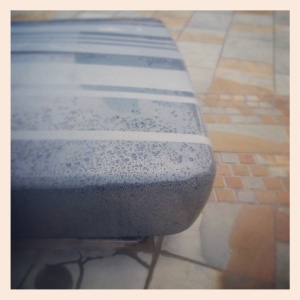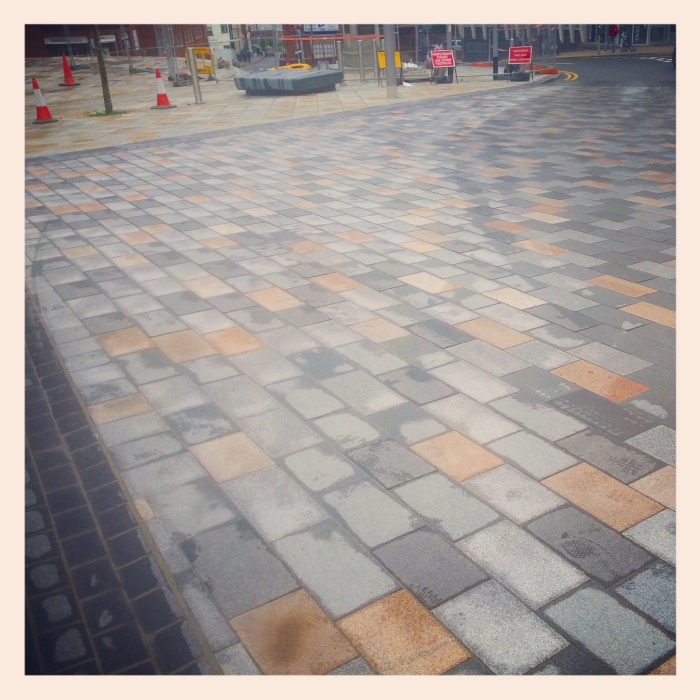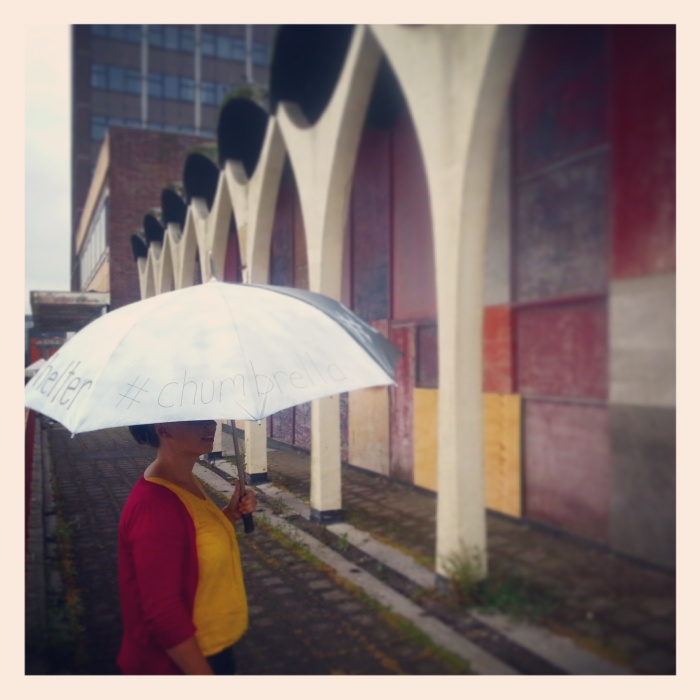Struggling to find life in shiny public spaces
“Cities have the capability of providing something for everybody, only because, and only when, they are created by everybody.” - Jane Jacobs
Can artists build a real relationship with city planners, regeneration professionals and perhaps most importantly, the people who use our streets? That was the question raised by Beneath The Pavement, a two day workshop for artists who want to work in public spaces.
Organised by AirSpace Gallery and supported by Appetite, the day brought four lead artists together – Anna Francis, Emily Speed, Mark Gubb and me. We each presented our approach to working as an artist in public spaces, which were similar but slightly different. The overlaps were significant, and probably represent the way most artists at the same stage in our careers work; we’re all interested in spotting gaps, all looking to make temporary interventions, all have an eye for the derelict corner, all enjoy a light humour, all find ourselves weighted down by the history of a place, and all question whether more formal urbanism really works.
Stoke’s problems – and opportunities – were laid out for us and the twenty or so artists attending in a series of walks around the city centre, taking us through old streets, abandoned buildings, back alleys, community spaces and into public buildings. That walking and talking made it clear that Stoke has two big hang ups, it is obsessed with the idea that its six original towns can’t make a coherent city, and it believes that its industry is dead. Both of these ideas are wrong.
All cities are a jumble of older places, loosely connected, threaded together across the years but still holding onto their original identities. Stoke has held onto this ‘we’re not a city’ like an article of faith, but, coming from outside, it feels irrelevant. Chanting it, ‘we’re not a city, we’re not a city, we’re not…’ makes no difference. Stoke is a small-scale city, permeable and human-scaled. Nowhere does it overwhelm a person. The city twists, turns, tumbles up slight rises and through informal spaces (not formal squares, but wide and curving public spaces). This does, sometimes, make it difficult to navigate – it’s not a legible city centre, doesn’t move you to a big central space, doesn’t allow you to navigate by landmarks and statues.
The buildings are good, across the decades; there are beautiful proud Victorian commercial buildings, as you’d expect, but also some great mid-century modernism – the curved arches in an abandoned shopping centre, the fine typography on Tontine Buildings, the bold space-age fins of the BBC building.
Stoke’s problems – and opportunities – were laid out for us and the twenty or so artists attending in a series of walks around the city centre, taking us through old streets, abandoned buildings, back alleys, community spaces and into public buildings. That walking and talking made it clear that Stoke has two big hang ups, it is obsessed with the idea that its six original towns can’t make a coherent city, and it believes that its industry is dead. Both of these ideas are wrong.
All cities are a jumble of older places, loosely connected, threaded together across the years but still holding onto their original identities. Stoke has held onto this ‘we’re not a city’ like an article of faith, but, coming from outside, it feels irrelevant. Chanting it, ‘we’re not a city, we’re not a city, we’re not…’ makes no difference. Stoke is a small-scale city, permeable and human-scaled. Nowhere does it overwhelm a person. The city twists, turns, tumbles up slight rises and through informal spaces (not formal squares, but wide and curving public spaces). This does, sometimes, make it difficult to navigate – it’s not a legible city centre, doesn’t move you to a big central space, doesn’t allow you to navigate by landmarks and statues.
The buildings are good, across the decades; there are beautiful proud Victorian commercial buildings, as you’d expect, but also some great mid-century modernism – the curved arches in an abandoned shopping centre, the fine typography on Tontine Buildings, the bold space-age fins of the BBC building.

These two periods – grand Victoriana, mid-20th century (Art Deco through to 60s Brutalism) track Stoke’s industrial wealth. The potteries which spread teapots, cups and saucers across the Empire adapted well, post-1945, as both expressions of New Elizabethan optimism and as high-tech industry, manufacturing ceramics for electrics. The decline came later.
And that’s Stoke’s second myth – that the big, empty sites mean Stoke’s industry is dead. That’s simply not true; it’s moved on, there’s no ripping coal and clay from the earth here today, but Spode, Emma Bridgewater, Portmeirion – these are still big names and they’re still be produced. That’s more major manufacturers, all well-known-names, than most British cities can muster. Be proud of your history – Minton, Clarice Cliff, Wedgwood, Susie Copper – for sure, but also be very proud of what you’ve got now.
Stoke’s city centre is undergoing something of a transformation. It’s being given a massive public realm makeover. The work is well-intentioned, and is much better than what went before. if you compare the way the new layout gives the car less authority over roads, to areas in the city which are still waiting for improvement, it’s going to change the way people use the city centre and deliver massive benefits.
But it still lacks focus, still lacks legibility and worst of all, includes too much Pointless Public Realm – space without purpose. The problem, really, is that while planners talk about ‘vibrancy’, and creating ‘mixed use’, and encouraging people to ‘linger’ – they also want to control space. So they try to plan out real vibrancy, allow only certain types of mixed use, and stop some people lingering. As a result, benches are split in two, to discourage rough sleeping, and seating is designed to be uncomfortable, so that teenagers and street drinkers don’t linger too long. There’s lots of space, but not in useful places, and not focused – empty space, waiting to be reclaimed and reused.

The council’s presentation of this work to Beneath The Pavement was interesting to watch; a example of two world’s not so much colliding, but existing in parallel universes, and surprised by a sudden glimpse through a window of each other. The council know that the work is needed, have given it a decent budget, and are working to a high quality. But in thinking of city-as-engineering-challenge, they’re missing the point made by good thinkers like Jane Jacobs, Lewis Mumford and Francis Tibbalds. They’re creating a blank, neat city not one for people to fill. This is where artists the artists working at Beneath the Pavement became most frustrated, but it’s also where they’re needed most.
“There is a quality even meaner than outright ugliness or disorder, and this meaner quality is the dishonest mask of pretended order, achieved by ignoring or suppressing the real order that is struggling to exist and to be served.” Jane Jacobs
But all of them avoided the neat, new spaces. And that’s where we need to go to work right now; before they become tomorrow’s failed visions of a better city, things we look back at and say ‘what were they thinking?’. The city’s planners might think that, in a year or two, they’ll have finished, that the job of work is over; that building new streets is a process with a start and an end. But the truth is, the layers on top of them, the gradual accretion of life and disorder, are what really make a city live. And that’s up to us. Let’s get started.








No comments:
Post a Comment